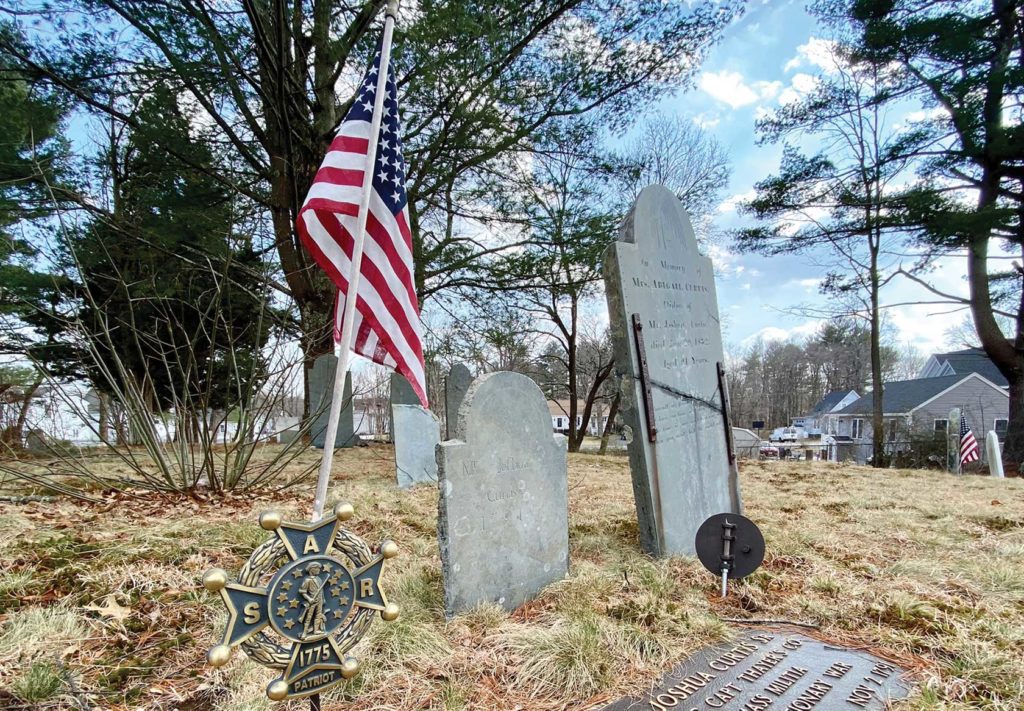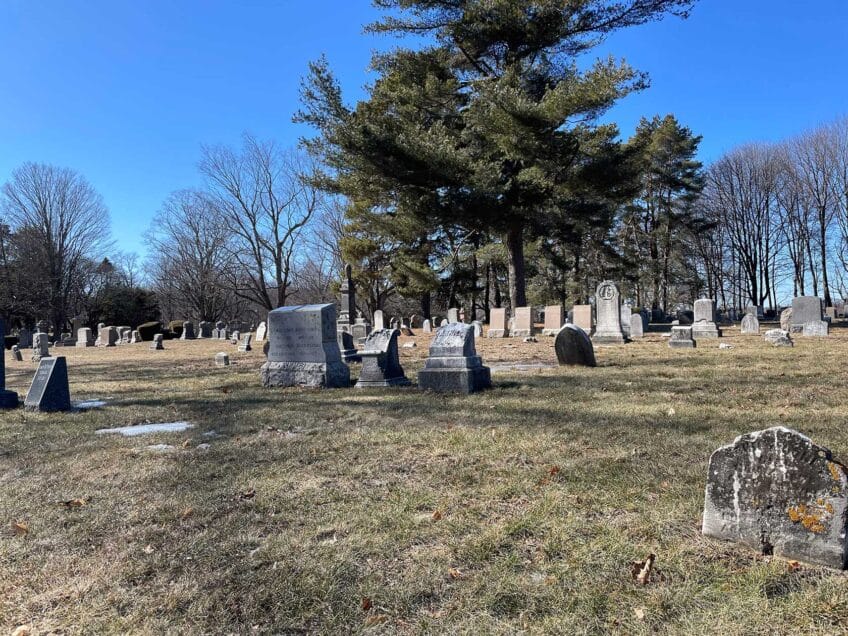
Cuffy Rosaria deserves folk hero status in his Massachusetts hometown of Abington; he has the rare distinction of appearing both in a runaway slave ad and in Revolutionary War muster rolls.
Cuffy was the patriarch of a cohort of five men of color who fought for Abington in the Revolution. He fathered two biracial sons who served three-year tours in the Revolution. He witnessed the Battle of Bunker Hill — a no-turning-back moment in American history. And with a surname tangled up in ten different spellings, his genealogy and his fate prove quite elusive.
Twenty-eight years before the Battles of Lexington and Concord, we find a 1747 ad in the Boston Evening-Post documenting Cuffy’s earliest known act of resistance: “Ran away from the Rev. Mr. Samuel Brown of Abington…a Mulatto Fellow named Cuffy.”
Cuffy was obviously apprehended. We know this because the ad placed by Brown, Abington’s first minister, is not the only source for insights into Cuffy’s life. In addition to being one of the 12 adults enslaved by Rev. Brown and later Josiah Torrey, Cuffy is one of five Abington men identified as Black or mixed Black and Wampanoag heritage who fought for American independence.
Further biographical details of Cuffy’s life are found in the Dyer’s transcriptions of the Cyrus Nash Papers by way of a Massachusetts Historical Commission report about a property at 429 High Street. The report mentions a long-gone house that occupied the property and, after the death of widow Pettingill, the “old house was then the home of Cuffy Rosier, a slave of Squire Josiah Torrey who lived farther north on this road…[at] 247 High Street.” The site of these slave quarters where Cuffy lived with his wife, Indian woman Dinah (née Lamb) Nummuck, would have sat close to the current town line of Abington and Whitman.
At the outset of the Revolution, we find Cuffy — now 48, presumably still short, and hopefully still well-fed—in the rolls for Capt. Hamlen’s Company starting on May 1, 1775, twelve days after the Lexington Alarm. But this would not be Cuff’s first go at military service. As noted in AATR, the enslaved Cuffy “volunteered” for service in the French and Indian War. By this time, in 1755, Rev. Brown had died, and his widow moved to her father’s farm with her second husband, Josiah Torrey, taking her bequest of enslaved people with her. Torrey sent at least three enslaved men to fight in the French and Indian War; of those men, Cuffy returned to marry Dinah and have two sons.
Since we don’t have his words, we don’t know the degree to which Cuffy’s Revolutionary service was “voluntary.” Did Cuffy see enlistment as a welcome escape from Torrey’s Abington slave-labor farm? Was there hope sparked by talk of liberty? Did Cuffy see military service as an avenue to better opportunities for his wife and adult sons? Although these questions remain unanswerable, history is clear about the movement of Cuffy and the rest of New England’s militiamen during the spring of 1775.
The Siege of Boston commenced as the British army retreated from Lexington and Concord. The New England militiamen pursued the British army and bottled them up on the small Shawmut Peninsula by building encampments at Chelsea, Cambridge, and Roxbury. British naval superiority allowed travel in and out of the port, but General George Washington soon arrived with a mandate to form a Continental army; forces multiplied, fortresses were improved, and the British were trapped.

A Revolutionary War marker in Abington. There is no memorial for African American soldiers who fought in the war. PHOTO: Wayne Tucker
Ten thousand residents fled the town of Boston while 1,000 loyalists filed in. The siege ended when, conceding that he was outgunned and at a geographical disadvantage, British General William Howe chose retreat, and 11,000 British soldiers and 1,000 loyalists shipped up to Halifax. This event is commemorated every March 17 in Suffolk County as Evacuation Day.
The pivotal event between repelling the British at Concord and the evacuation of Boston, of course, was the Battle of Bunker Hill. Before George Washington assumed command in Cambridge in July, Massachusetts General Artemas Ward ordered his troops to build a fortification in Charlestown. A short distance across the harbor, General Howe saw the Breed’s Hill fortification as an aggressive encroachment on the British position and he and his generals decided that the Patriots’ action could not go unchallenged. On June 17, 1775, Howe launched the bloody attack on the American redoubt. Although the dogged British troops eventually secured the fort, the losses they sustained were immense and victory was pyrrhic. Furthermore, any hope of a peaceful end to the American rebellion that began on Lexington Green had vanished.
Cuffy was at camp in Roxbury on the day the British attacked Bunker Hill. Connecticut Col. John Trumbull was also stationed there.
“From the upper windows of Thomas’s headquarters, near the meeting-house, Charlestown was in full view, though at too great a distance for the naked eye to discern what was doing on the day of the Bunker’s Hill battle,” Trumbull begins in one account of the day.
It became obvious to commanders at Roxbury that hostilities had erupted across the harbor. Cuffy Rosaria and his fellow soldiers were on alert.
At night, Trumbull notes, “the action kept up” and he describes the “frequent fire of shot and shells in the direction of Cambridge.” Nightfall provided a viewing advantage for the troops like Cuffy, now on alert at the Roxbury high ground. Trumbull provides this vivid vignette:
“The roar of artillery fired at—the bursting of shells (whose track, like that of a comet, was marked on the dark sky, by a long train of light from the burning fuze)—and the blazing ruins of the town, formed altogether a sublime scene of military magnificence and ruin. That night was a fearful breaking in for young soldiers, who there for the first time, were seeking repose on the summit of a bare rock, surrounded by such a scene.”
Cuffy’s adrenaline must have been flowing and, although 3.5 miles away, he would’ve been fully aware that war was raging. Was Cuffy worried that the bloodshed would spread to Roxbury? We can only imagine.
Cuffy Rosaria was not the only African American at Roxbury Camp, and more than 100 men of color fought in combat at the Battle of Bunker Hill. This, too, is no new revelation.
In Trumbull’s famous painting The Death of General Warren at the Battle of Bunker’s Hill, 17 June, 1775, a version of which hangs in Boston’s Museum of Fine Arts, Trumbull depicts the visages of two Black men.
Cuffy’s Coda
We learn through Cuffy’s entry in Massachusetts Soldiers and Sailors that his Revolutionary service lasted for “3 mos., 1 week, 1 day.” Counting out from May 1, this would translate to August 8, 1775. A transcript of the Cyrus Nash Papers, a voluminous personal diary of Abington history held by the Dyer Memorial Library & Archives, records Cuffy Rosaria’s death as August 6, 1775. On one hand, this could mean that Cuffy died seven weeks after Bunker Hill at the Siege of Boston. On the other hand, we have a muster roll index card for a 54-year-old Cuff Rozery of Abington, dated 1781, showing service at West Point in Col. John Greaton’s 3rd Regiment. This age, 54, comports with the ages for Cuffy given in the runaway ad and the French and Indian War record — all three documents point to a 1727 date of birth.
Either way, Cuffy Rosaria’s legacy did not end at Roxbury. His sons Cuffy and Silas would enlist in the Continental army in 1777 and serve full three-year hitches. Cuffy’s family is a tricky genealogical puzzle to piece together since I find ten different versions of the Rosaria/Rosier surname across multiple sources. It was clear that Cuffy, Jr. was very likely Cuffy Rosaria’s son despite the surname variations. But it was long unclear if Silas, who appears under the variation of “Rositer,” fit into the family.
It is Silas Rosaria/Rosier/Roso’s detail-rich Revolutionary War pension file, which contains documents drawn up by Silas’s widow Phebe Wamsley and her daughter Zerviah Gould Mitchell, that confirmed the family lineage. On two occasions it is stated that Cuffy, Sr. was Silas’s father.
There is no visible memorial for Abington’s five forgotten patriots.
In roaming any antiquarian graveyard in Massachusetts, we see medallions and flags placed by the Sons of the American Revolution to mark Patriot gravesites. What we rarely see are headstones and SAR medallions for our forgotten patriots. These memorials are conspicuously absent for Abington veterans Cuffy Rosaria, Cuffy Rosaria, Jr., Silas Rosaria, Brister Gould and Primus Cobus/Coburn.
The hands of these men both helped to build Abington and carried arms on her behalf. It’s past time that these soldiers get their due.
This article is an abridged version of a blog post from Wayne Tucker’s Eleven Names Project website, which tracks the histories of people of African and Native American descent enslaved in New England.







